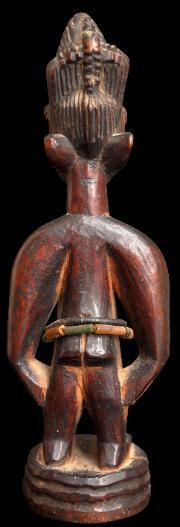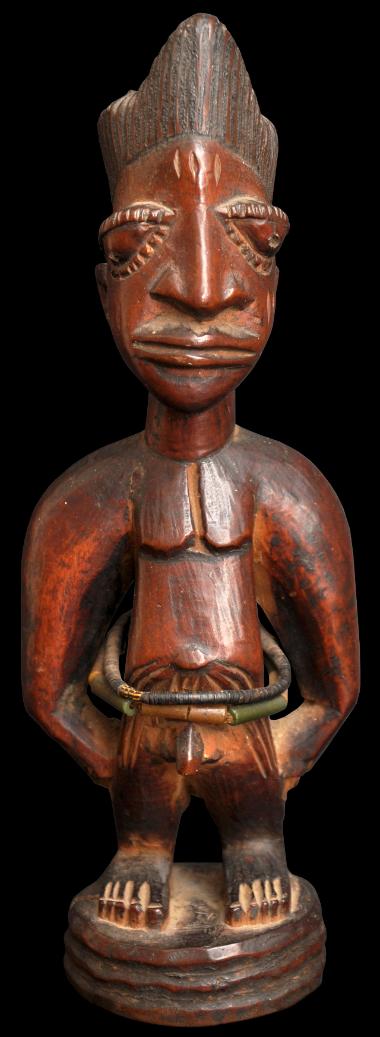
Yoruba Ibeji Twin
Male Ibeji Figure (Ere Ibeji)
Oyo Ibuke Region, Yoruba people, Nigeria
circa 1920
height: 26.5cm, width: 9cm
This male Ere Ibeji figure stands with his hands on his hips, and has an appealing face that is typically Yoruba: it has sleepy, almond-shaped eyes, enormous flared nostrils, full broad lips, and strong ears. His eyes are particularly bulging. They have heavy, thick eyelids decorated with incised eye lashes. His irises are pierced. (Ere Ibeji is a combination of Yoruba words: ere ‘sacred image’, ibi ‘born’ and eji ‘two’.)
Three sets of scarification are on his face: on the forehead, under the eyes, and beard-like ones along the jaw lines. The over-sized head is deliberate – the head is where the spirit resides. Among the Yoruba, the over-sized head is associated with one’s destiny, and can be a measure of one’s likely success or failure.
The raised coiffure resemble a tiered crown. The top of the coiffure is plaited intricately into a cross.
The figure wears waistbands of green and yellow-blue semi-transparent tubular beads, and a thread of finely-cut black coconut disks with some coloured-beads. The waistbands hang between the figure’s belly button and his protruding penis, hiding the incised pubic hair beneath. Tukula powder has been applied to some parts of the body. It is still visible where it was applied. This powder was ground from tukula wood and was both cosmetic and a protection from insects and from the sun. Tukula also was believed to have healing properties and magical powers.
This piece has excellent patina and obvious age. The body parts where tukula powder was applied but no loner is present, especially where the hips and the fingertips touch, reveal a surface of lighter wood colour. There is an age-related crack from the base onto the figure’s right foot. Importantly, even the items of jewellery that have been used to adorn this Ibeji figure have clear wear and patina.
Yoruba people have the highest dizygotic (non-identical) twinning rate in the world. The births of twins amongst Yoruba women are four times more likely than anywhere else. Unfortunately, the mortality rate of the twins also was high. Ere Ibeji figures were carved as spiritual representations of the twins who died. These figures were commissioned from village carvers, who were also often highly trained priests (Babalawo). The images were carved as adults, rather than as the deceased infants. It is common in African sculpture that representations of children are made with adult-like qualities, including elaborate coiffures, scarifications on the face, fully developed breasts (on female figures), pubic hair and prominent genitalia. They were usually placed on a shrine dedicated to Elegba (a divine messenger deity) in the living area of the house and fed, bathed and dressed regularly. These figures were particularly special to the mother, who kept them close to her and caressed the figures in a loving manner, hence the wear that genuinely old examples exhibit.
Provenance: UK art market.
References
Bacquart, J. B., The Tribal Arts of Africa, Thames & Hudson, 1998.
Inventory no.: 1587
SOLD













